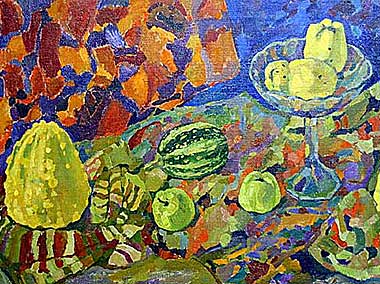| |
Hanging Paintings - Feng-Shui Recommendations
By Ned Ryerson
Where is the best place to hang a picture?
Every artwork, be it a painting or a photograph, generates its own certain kind of energy and creates a unique mood in the viewers. This energy depends on two factors:
1. The dominating color in the picture.
2. The content of the picture (subject matter and theme)
How does one figure out which picture could be useful and fitting in which room: living room, dining room etc? Each room has it own characteristics, such as color, style, size, view from window, and therefore has its own energy. So, in order to fit into a particular room, a picture has to compliment such energy, and not to contradict it. This is only a general idea, to be precise in choosing the picture and finding right place for it, we have to make certain feng shui calculations.
The living room
Try to experiment in order to choose a proper picture for the living room. You have to find out what colors are most suitable with the energy compliance (of the space). The method is very simple: let's take a piece of fabric of blue color with a size that is approximately same as that of the picture and somehow fix it onto a wall. Now relax and try not to think about anything. You can even to shut your eyes. Concentrate on your feelings - how have they changed? Are you feeling comfortable - more comfortable than before you hung the fabric? Or the contrary - does it irritate you? If so, then change the piece of fabric of another color, another tone. If you subconsciously feel that such a color makes you comfortable, and the energy of the room has grown stronger - that's it, you've found the proper color. Now you're ready to buy the picture according o the color scheme you've just found. Your intuition and experimenting with different colors in space will help you choose the appropriate picture.
Dining room/Kitchen
Pictures with green being a dominating color are usually best for a kitchen. Every process that goes on in the kitchen, whether it be cooking food or eating it, is related to the natural element. This element of nature is affiliated with the green color. Best-suited paintings for this task are usually landscapes of green fields or trees. Another color that's good for a kitchen would be red (such as compositions of fresh harvests). The red color is related to fire, which is symbolically a domestic element. Aside from symbolism, it is a long-known fact that the red color has a strong property of stimulating one's appetite.
Bedroom
When choosing a painting for the bedroom, it is usually best to avoid choosing dynamic images. For example, a painting with a heavy waterfall or an erupting volcano is not very relaxing, and therefore not the best choice of subject matters for a bedroom. You will subconsciously recall it while you sleep and you will sense a certain uneasy feeling of being near danger. Therefore, the best choice of imagery for the bedroom is one that is peaceful and calm, for example, a slow river in the middle of a forest, with clear water and lilies. However, the scenery has to be calm and relaxing with positive energies, and not give uneasy or morbid feelings, like those one would get from a dead tree or a cemetery. In the end you have to once again experiment with the paintings, and listen to your intuition regarding the color and subject matter of the painting and whether it compliments your bedroom.
Children's room
A child's bedroom is different from an adult's. In order to pick out a painting for a child's bedroom, one must look at the child itself. The first thing to consider is what the child's favorite colors are. A child is more affected by negative and positive energies of his or her surroundings, more so than an adult, and a child has a stronger sense of what color will be most suitable. Consequently, if a child likes the color red, then it is preferable to get an image where red is the more dominant color, such as a red sunset. If a child prefers the color blue, then it is best to get a painting where the blue color is dominant, for example a painting of a blue ocean. Another thing to look for is the child's character and temperament. If a child tends to be quiet, timid, or generally calm, then the painting you choose should be slightly more energetic. If the child, by nature, is very energetic, restless, and loud, then it is best to avoid putting dynamic images in the child's room. Instead, it's more fitting to find a slightly relaxing image.
General notice
The main piece of advice, is to choose a painting by experimenting and using your intuition on whether the painting compliments the rest of the room. If you can do that, then everything else should prove to be much simpler.
If your table is set up so that when you sit, you do so by looking at a wall, then it's best to hang a painting with perspective in front of you. This will create a subconscious feeling of volume and atmosphere in front of you. If you have a wall behind you when you sit, hang a painting of something enclosed, such as a thick forest. This will give you a feeling of easiness, security, and support.
It is advised to not hang paintings of destroyed houses and buildings, or pictures of dead trees, because these tend to give off a negative energy.
Ned Ryerson
interior designer, decorator and editor. For more from Ned please visit http://www.studiotreasure.com |
|

